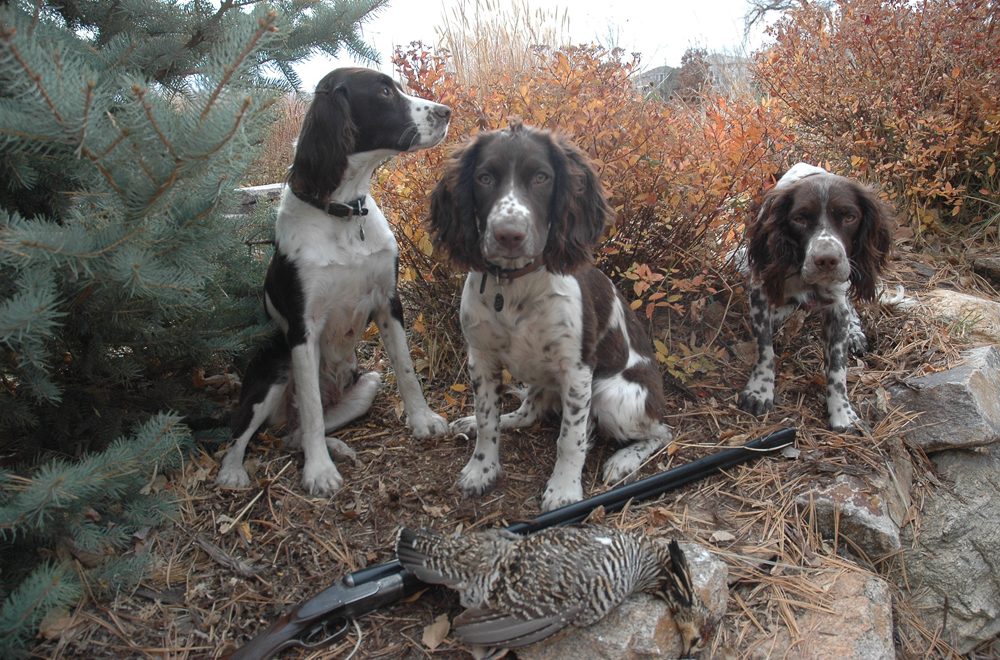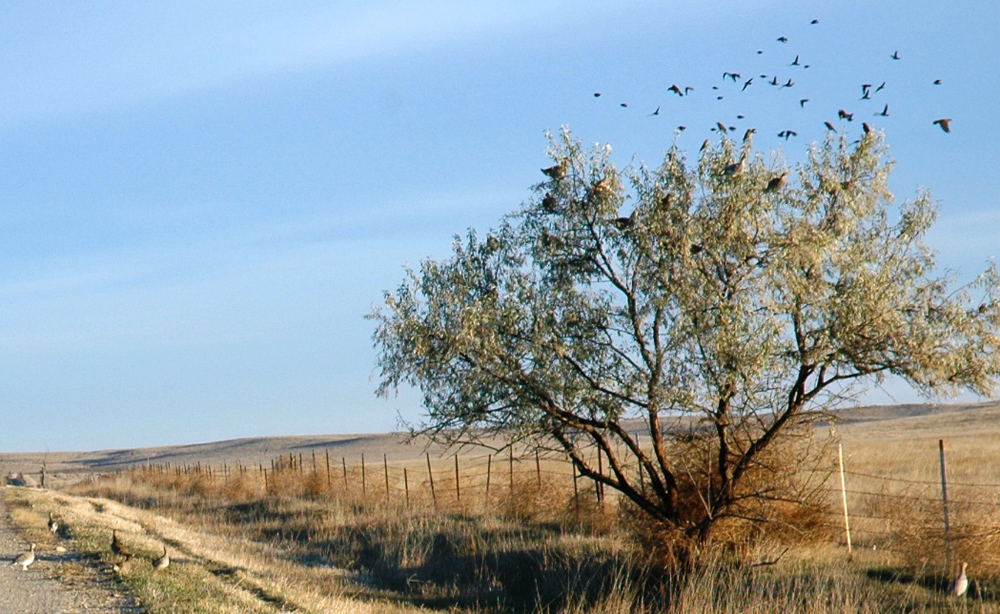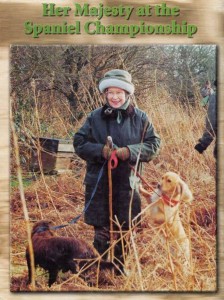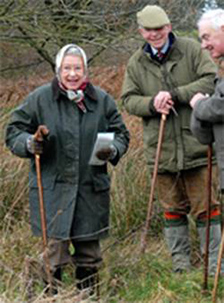Prairie Grouse Numbers are “Way Up” on the Rosebud!

This past season, I saw more prairie grouse, both sharptails and Greater Prairie Chickens then I’ve seen in the 15 years I have spent hunting the Rosebud Indian Reservation in the fall. There has actually been a steady increase in grouse numbers over the last few years with warmer temps, but this past fall was the best ever! Chance Colombe, rancher and top-pro guide out of Mission SD, is looking forward to another remarkable season coming up! I have been blessed to hunt with Chance and his family over the years. They are salt of the earth! Chance is now offering hunters a few specials.

I definitely have a bad case of Prairie Chicken Fever as this beautiful, wild game bird has become my favorite prairie pursuit! In fact, I believe a “Double Boomer” (a boomer is a male prairie chicken) to be the ultimate upland accomplishment. I have been gifted with three so far and they all played out right in Chance’s back yard! A covey rise of Greater Prairie Chickens flushing fast, chuckling and flashing their fanned tails on the native prairie is about as special as it gets when it comes to western wing shooting adventures. Once numbering in the millions, large concentrations of prairie chickens are now only found in isolated pockets of our disappearing prairie – the last frontier for these indigenous game birds. One can only hope and pray that these rare and beautiful “pinnated” grouse do not go the way of the Heath Hen. There aren’t many wild places left where hunters can bag a limit of prairie chickens several days in a row. One such wild place that I have found is South Dakota’s… Rosebud Indian Reservation. Hunting chickens on tribal ground offers an incredible experience that is steeped in the history and mystique of these native lands.
Hunting with my field bred English Springer Spaniels under the wide expanse of the Rosebud prairie sky, we took pause. Thick, darkening clouds hung ominous and low overhead, when suddenly a single beam golden light engulfed us in a heavenly spotlight. A surreal quiet came over our hunting party. I imagined the sounds of thunderous buffalo herds, wagon trains and even the victory cries from Native American hunters… where now, there were only the whisperings of native grasses in the wind. Autumn seemed to come alive – complete with lightening, thunder and rain that evaporated before it hit the ground. I recall looking breathlessly out onto the unforgiving prairie – bolts of lightning shocking the earth like daggers. A familiar sight I’m sure over many autumns gone by – Native and other hunters, past and present, forced to take pause, breathe deeply and appreciate the powers Mother Nature can deliver.
On the Rosebud, you’ll find a rich diversity of tribal grasslands that have been preserved over time, due mostly to the Lakota way of life and the respect they have for their lands. This virtue has been passed down through many generations in this ancient culture and consequently, much of the landscape still looks like it did when buffalo roamed freely there. Chance’s ranch is one such special place! The Rosebud Reservation encompasses 1.8 million acres of native grasslands, a good portion of which is unturned prairie. Majestic buttes surround peaceful valley creek bottoms that hold crops like sunflower, alfalfa and corn. The county side is a patchwork of agriculture and lots of pristine grass – the perfect habitat for prairie chickens, sharptail grouse and wild roosters. When employing a Native American guide, a requirement by the Lakota tribe, hunters have access to it all. Our licensed guide, Chance Colombe, at “Prairie Grouse Haven” has been focused for years on locating concentrations of prairie chickens.
Each season, Chance and I have had the good fortune of being entertained by a diverse line up of gun dogs. Their masters bring them to the Rosebud prairie to check off an important item on their bird dog bucket lists – the Greater Prairie Chicken. The goal of many hunters is bagging a mountable mature male prairie chicken, or “boomer” as we call them. This trophy game bird has beautiful Pena’ feathers growing long off the back of his handsome neck. These feathers stick up above his head like horns during his mating dance on the spring Lek. The crème de la crème is bagging a double boomer! The Rosebud is teaming with Greater Prairie Chickens. There are also lots of sharptail grouse and wild roosters, as well as migrating doves and Wilson’s snipe on this tribal ground. It is a wildly vast and untapped grassland landscape supporting an upland game bird Mecca. In other words, a haven for upland hunters and their gun dogs.
Contrary to popular belief, close working flushing dogs, can excel on prairie grouse, while wide ranging pointing breeds simply make the hunt easier. Savvy flushing dog enthusiasts armed with knowledge about prairie grouse habitat and behavior can also be extremely effective. After hunting these indigenous pinnated grouse for fifteen years with my English Springer spaniels, I have come to know these birds well and… how to hunt them.

When October delivers enough cold, prairie grouse travel to traditional congregating areas looking for other family groups to covey up with for warmth at night. Prairie chickens are now considered to be “partial migrators” as they migrate in both the spring to the Lek for mating and in the fall to covey up. This is a fairly new classification within the prairie grouse species and was asserted via a research study out of the University of Northern Colorado where attached radio transmitters were used to track the migration patterns of Greater Prairie Chickens in north east Colorado. These signal transmitting prairie chickens followed a traditional pattern in their annual migration route… up to a fifty mile junket. The breast meat on any of the prairie grouse species is red, which explains their ability to fly long distances. The fact that they migrate makes them more challenging to hunt. Along their migration route, chickens have established congregating areas where they gather to covey when the weather requires them to group up for warmth and survival. Chance has a prairie chicken congregating area right in his back yard. He plants crops each year to attract the chickens. His family has many thousands of acres of tribal ground allocated to him that he ranches. Chance also guides hunters for trophy whitetails. He grew up grouse and deer hunting with his dad and with a lifetime spent out on the Rosebud prairie, he has been able to identify many traditional congregating areas as well as where the big whitetail bucks are.
October and November have become my favorite time to hunt chickens. The Pena’ feathers on the boomers are fully grown and the temperatures are cooler for dogs. The grouse are in coveys and can be found along their migration route in their congregating areas. A covey rise of chickens almost always presents an opportunity to score a double. Our friend, Ross Starner, with his German short-hair pointers, amazingly bagged a double four days in a row while hunting at Prairie Grouse Haven! Habitat is key to finding prairie grouse. Native grass or unturned prairie is an essential component. Near-by crop fields serve to fortify the grouse in these native prairie grassland areas. We have found more sun flower seeds in the crops of prairie chickens than anything else. Corn and Alfalfa are also prairie grouse favorites.

Spend some time in prairie grouse country and you will see a tree full of grouse, all on the lookout. Sight and flight is their main defense. They tend set up in the grass on a rise where they can see danger from a distance. We hear a lot from hunters who have experienced wild flushes while grouse hunting. Our secret is to sneak in on them from behind the rise.
Prairie grouse are usually found on the lookout from a high point in the landscape and out of the wind. This is the most comfortable position to watch for predators like hawks and coyotes, who are scenting or flying into the wind while hunting. The wind is a key factor in locating prairie grouse. The good news is that the wind does blow out on the prairie. Wind actually concentrates the grouse into likely spots out of the wind with the birds looking downwind for approaching predators. So, a strategy that has really worked for me is to hunt with the wind at my back. While this may appear counter intuitive, I have seen dogs adapt much easier then hunters. Grouse usually flush into the wind, in this case, toward the guns. This set up offers more time to get your gun up and makes those doubles more possible. Doubles after all, are the gentleman’s blessing from the covey birds.
Eventually, the big boomers no longer appreciate all the hen-pecking going on in their coveys. So, they separate themselves from all the hens, but satellite near-by. This satelliting behavior from the males is also seen in other species in the animal kingdom, like elk and certainly in our own… ha! We have encountered up to a dozen satelliting boomers together in bachelor groups while circling about after we have flushed a big covey. On more than one occasion, this strategy has produced good fortune – the ultimate… bagging a Double Boomer!
There is something very special about pursuing these indigenous pinnated grouse with a gun dog. To do it with a double gun that has providence back to the turn of the century serves as the adventure’s frosting. A primal spirit is out there to be discovered on the Rosebud. Many Lakota scared places are scattered across the country side. The majestic landscapes are rich in Native American history. Chance Colombe does an excellent job lending his unique perspective to the history of the land and his beloved Sioux tribe. The fact that Chance is a direct descendent of two famous Lakota chief’s, Red Cloud and Red War Bonnet, make him a natural leader.
Finally… the rain stopped and the skies cleared with a stiff breeze. Sunny, my lead spaniel worked close and fast for scent. Ollie and Remi took it all in following and slipping quietly through the unturned prairie. They then streaked by in a flash, right under foot, through soft native grasses, floppy ears flying in their wake. With canine ninja athleticism, including some big air springs, their excited tail flagging gave us notice that grouse were about. I picked up the pace, knowing well and good that a stylish gun dog moving through cover hot on scent is its own reward; not to mention the rush of a covey rise with simultaneous wing beats and the adrenaline that follows. My eyes glanced over the sleek lines on my turn of the century English double and I distracted myself momentarily. The sheer beauty of the tribal landscape as our back drop almost stole my breath away. I felt fully alive in the uplands. The dogs snapped me back, flushing a couple dozen chickens in an unforgettable rush overhead. At times like this, it seems as though my gun dogs and I are kindred spirits. We are compelled afield by common primal instincts as we pursue the same goal. Separately, we would fail woefully, but as a team we are formidable! My vintage side-by-side came up and I strained to focus on just one bird. I was blessed that day with a double, my spaniels delivering their birds to hand. The other hunters took chickens also and my dogs assisted with the retrieving. We all sat down together in the native grass under the wide expanse of the Rosebud prairie sky savoring the moment. The dogs pranced about, scent shocked and sniffing the birds while our fingers smoothed beautiful plumage. Aloud, I gave special thanks to God for good comradery and our bagged Rosebud prairie chickens.
Next season, with grouse numbers being way up, Chance is offering hunters a discount if they bring friends along to hunt and… for fathers with sons and/or daughters, children hunt FREE under the age of 18! Come join us for the hunt of a lifetime!
For more information: Contact Chance Colombe phone (605) 828-7475 and Scott Winston via email [email protected] or call 303-250-0302.



